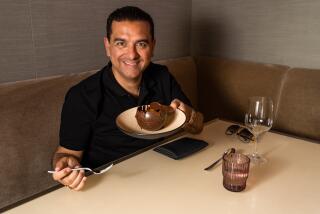Cake : IN THE KITCHEN : The Dissenting Baker
- Share via
I am not a baker, and a baker I will never be.
This has to be attributed to nurture rather than nature. Though my mother was not a kitchen-type person, as much as she was any kind of a cook she was a baker, and I grew up around snickerdoodles and chocolate chips, Grandma Smith’s hickory nut cake and julekake , and the occasional loaf of homemade white bread.
Even so, when I seriously began learning to cook, I lived at almost 6,000 feet above sea level. At that lofty clime, baking is not for the light-hearted. That is the land of “decrease amount of baking powder by one-third at 3,500 feet, by one-half at 5,000 feet and by two-thirds above 5,000 feet . . . raise the oven temperature by 25 degrees . . . do not beat eggs quite as much as usual. . . .” You get the picture.
Even then, there’s no guarantee things will work out. I vividly remember making a half-dozen heavier-than-lead spice cakes in one day before finally deciding the whole thing was just one big pain in the epice.
That’s not to suggest that my not being a baker is strictly a matter of atmospheric pressure. More to the heart of the situation, I believe I am constitutionally unfit for baking. Bakers are recipe followers, the good soldiers of cooking. If you see a recipe that takes three pages of instructions to use five ingredients, you can bet it’s a cake. Bakers like instructions, the more detailed the better. Tell them exactly what to do and they’ll obey without question. I think there’s a certain security in this--if things don’t work out, they can claim they were only following orders.
*
As for myself, I’m a messy cook, direction-wise. Give me a recipe and I immediately start breaking it down, figuring how to change it, altering the procedures and ingredients in my head to come up with just the result that pleases me. This process continues through the actual cooking. In the kitchen, I’m a dabbler and a dipper, tasting and adjusting as I go along. For me, a dish isn’t finished until it’s on the plate . . . and even then it’s not safe from a little last-second tucking and tasting.
Give bakers a sturdy stand mixer and a measured set of ingredients and they’ll have something in the oven without so much as stealing a lick. Can you imagine?
Bakers tend to be decorators. They’re icers and fussers, and they make things like sugar roses and basket-weave cakes. It’s not that I don’t like attractive food, it’s just that I don’t think there’s much you can do to make anything more beautiful than the bronzed fruit and dark, crumbly crust of an apple crisp--certainly not painting chevrons on it.
All of this is not to suggest that bakers are bad people. Some of my best friends are bakers. And some of them are even pretty good cooks. In fact, probably the best cook I’ve ever known started out as a baker. I will happily admit that there is something about the meticulousness and almost religious discipline of a good baker (it’s no accident that professional bakers usually begin the workday at about 3 a.m.) that can make for an inspired cook . . . provided they can get past the whole baking thing.
*
Neither is this to suggest that I don’t, myself, bake. In fact, from time to time I’ll get on a streak of baking and pop out cakes (though usually topped only by a dusting of powdered sugar, or a drift of whipped cream) and cookies (usually the ones that fit the Italian description “ugly but good”) like a regular Barney Crocker.
It never lasts, though. When it comes right down to it, I’m one of those oddballs who would rather have fruit than chocolate. While I’m perfectly happy having my cake, in all honesty, I’d just as soon eat a peach.
As a result, the cakes that I tend to make most frequently are rather plain things that serve as bases for other ingredients. This almond cake from Lindsey Shere is a perfect example. While it’s delicious by itself, with an extremely moist, almond-y crumb, it’s best when served with fruit of some sort--apricots and peaches in the summer, poached pears in the fall, maybe a dried fruit compote in the winter.
*
My contribution to this recipe is simply converting the whole thing to the food processor. It comes out a little denser this way, but in my book, that’s an attribute. Besides, the whole thing comes together in less than 10 minutes, before baking. It’s a cake even a non-baker can love.
*
Adapted from Lindsey Shere’s “Chez Panisse Desserts” (Random House: 1985).
ALMOND TORTE
1 1/4 cups sugar
8 ounces soft almond paste
1 1/4 cups softened unsalted butter
1 teaspoon vanilla
6 eggs, at room temperature
1 cup flour
1 1/2 teaspoons baking powder
1/4 teaspoon salt
In food processor work bowl, process sugar with almond paste until paste is in small pieces. Add butter and vanilla and continue processing until mixture is smooth. Add whole eggs, singly, and process until mixture is light and fluffy, about 3 to 4 minutes. In small work bowl, combine flour, baking powder and salt. Sprinkle over butter mixture and process in 2 or 3 short bursts, just until flour mixes in well.
Butter and flour loaf pan (9-inch springform) and pour in batter, smoothing top evenly. Bake at 325 degrees 1 hour to 1 1/4 hours until wood pick inserted in center comes out clean and center feels springy when pressed gently with tips of fingers. Makes 12 servings.
Each serving contains about:
396 calories; 137 mg sodium; 158 mg cholesterol; 27 grams fat; 35 grams carbohydrates; 6 grams protein; 0.25 gram fiber.
More to Read
Eat your way across L.A.
Get our weekly Tasting Notes newsletter for reviews, news and more.
You may occasionally receive promotional content from the Los Angeles Times.











